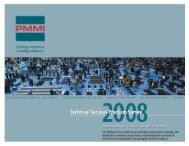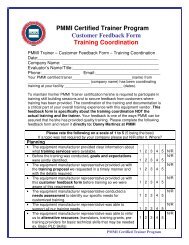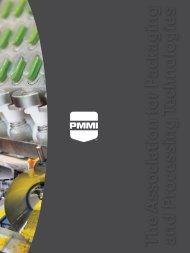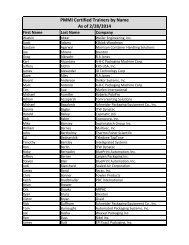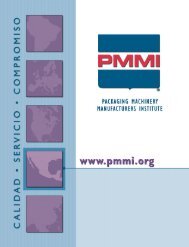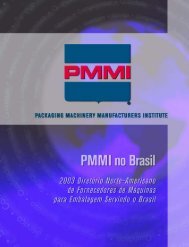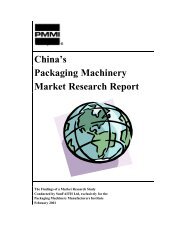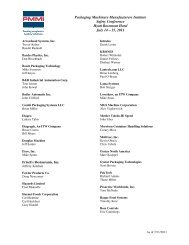Canadian Packaging Machinery Market Research Report - PMMI
Canadian Packaging Machinery Market Research Report - PMMI
Canadian Packaging Machinery Market Research Report - PMMI
Create successful ePaper yourself
Turn your PDF publications into a flip-book with our unique Google optimized e-Paper software.
3.0 THE FOOD INDUSTRY<br />
3.1 INDUSTRY OVERVIEW<br />
In 2001, the last year for which complete industry data are available, the <strong>Canadian</strong><br />
food processing industry shipped goods of its own manufacture valued at<br />
approximately C$56 billion, a 7.4 percent increase over 2000. The value of the<br />
industry’s shipments represented 10.2 percent of the total value of Canada’s<br />
manufacturing shipments in 2001. Statistics Canada data for 2001 indicate that the<br />
industry employed 222,000 people and that it was composed of 4,910<br />
establishments.<br />
Canada’s food processing sector is oriented primarily towards the domestic market,<br />
as 72.5 per cent of sector shipments were sold domestically in 2001. Over one-half of<br />
the sector’s shipments in 2001 were from two categories: meat (33.9%) and dairy<br />
(17.7%). The share of production that Canada exports, however, has increased from<br />
9 per cent to 27.5 per cent between 1988 and 2001. Imports have also increased<br />
from 10 per cent of the apparent domestic market in 1988 to 21.4 percent in 2001. It<br />
should be noted that the definition of the food processing sector, as used in this<br />
report, excludes the beverage and the animal food producing sectors. It should be<br />
further noted that tea and coffee manufacturing has been included in the beverage<br />
industry section of the report instead of in the food manufacturing industry section.<br />
Although the bulk of food processing activity occurs in Ontario and Quebec, the<br />
economic significance in terms of the share of regional manufacturing activity is<br />
greatest in the Atlantic and Prairie Provinces. Plant locations also vary - red meat<br />
and fruit and vegetable processing plants tend to be located near sources of farm<br />
production, while fluid milk and bakery product plants tend to be clustered near large<br />
centers of population. Activity in the major sub-sectors occurs in every region. Meat<br />
processing is generally the most important activity in each region, particularly in the<br />
Prairie Provinces. Dairy and meat products are the major products in Quebec, with<br />
the share of total shipments of dairy products being significantly higher than in most<br />
other regions.<br />
The food processing sector is fragmented, diverse, and is dominated by a relatively<br />
small number of large and very large firms. The food processing sector is composed<br />
of relatively large <strong>Canadian</strong>-owned multinational enterprises (MNEs), foreign-owned<br />
MNEs, large and small co-operatives, and small and medium-sized enterprises<br />
(SMEs), both <strong>Canadian</strong> and foreign-owned. Although some <strong>Canadian</strong> food sector<br />
firms are relatively large, in general, <strong>Canadian</strong> firms are smaller and less diversified<br />
than many of their major U.S. competitors.<br />
A number of the large and medium-sized firms are publicly listed companies, while<br />
the small enterprises tend to be privately owned. Most foreign-owned firms are<br />
privately held by their parent corporations. Co-operatives, which account for about 20<br />
percent of the value of shipments, play an important role in the <strong>Canadian</strong> food<br />
SMG/Columbia Consulting Group Page 28



